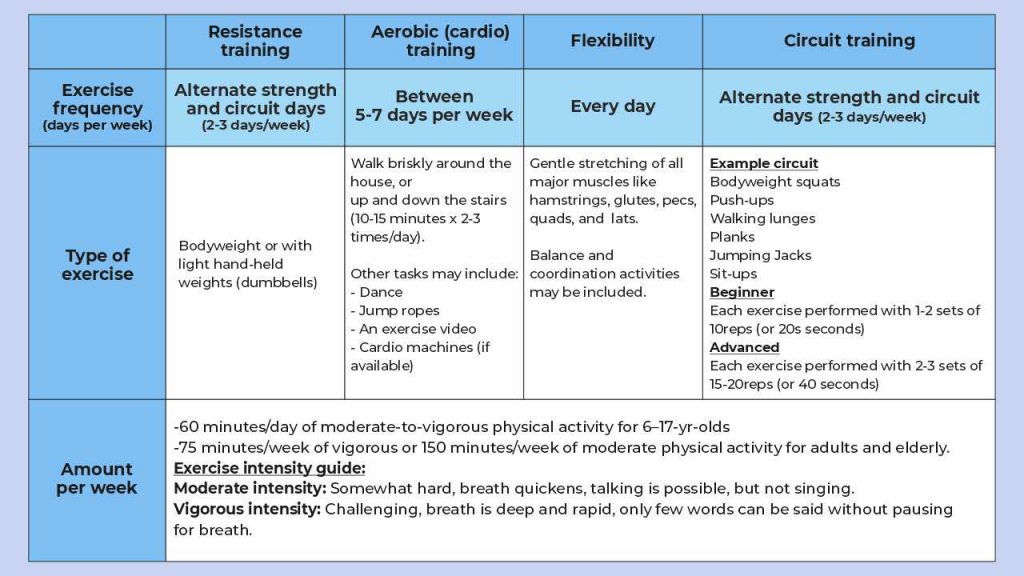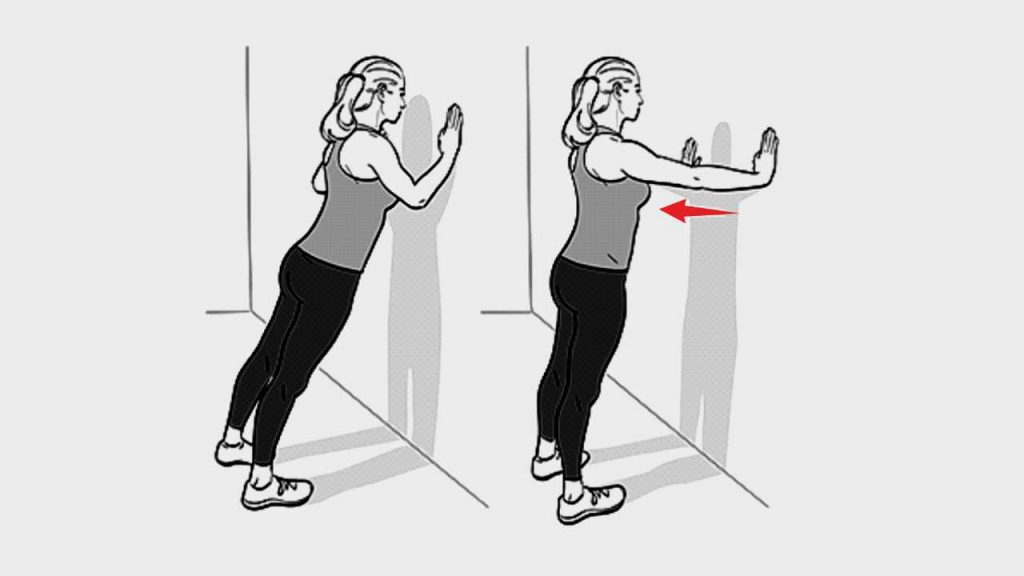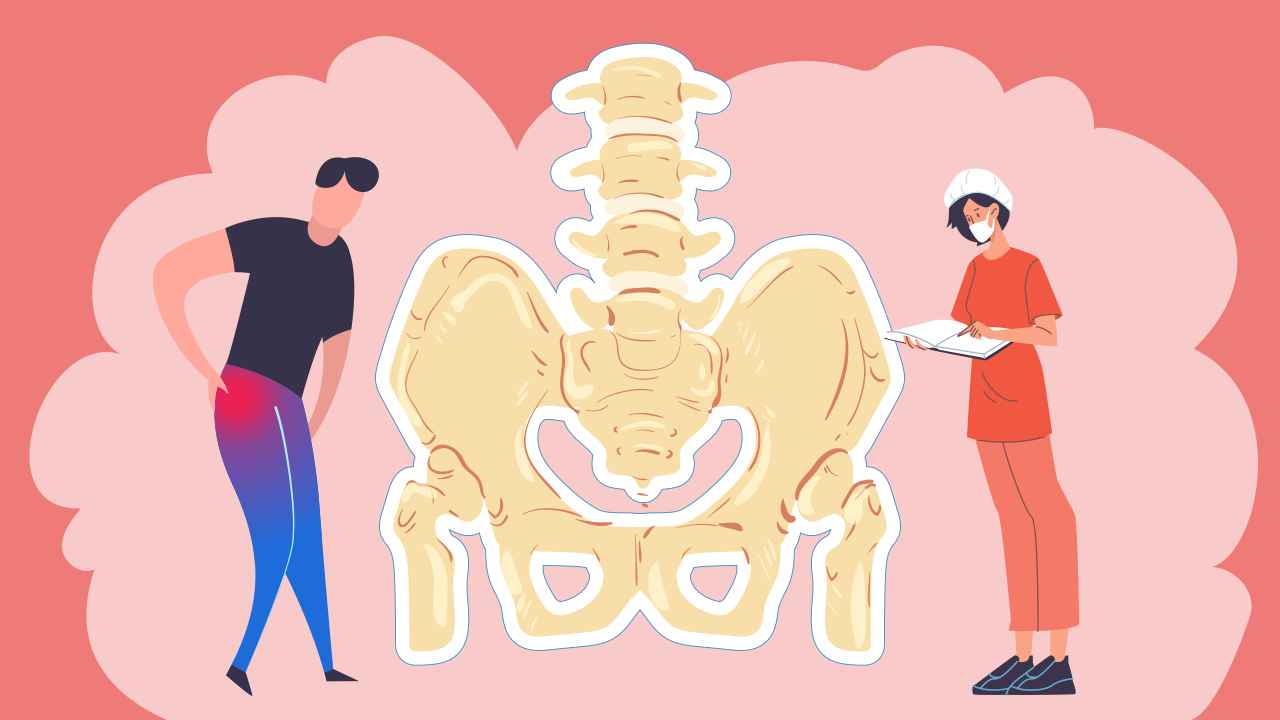
How to Train Safely and Avoid Injuries at Home

Since the emergence of the SARS-COVID-19 virus, there have been increasing concerns over community viral transmissions. Due to several government-mandated community restrictions across the globe, individuals have had to stay home more often and avoid various social and travel activities.
Subsequently, home-based studying, working, and physical exercising have become popular alternatives to community and/or on-site options. With regard to physical exercise, recent recommendations have been made concerning the amount and type of home-based training one should undertake. Such suggestions have been widely screened and promoted by several international regulatory bodies including the American School of Sports Medicine (ACSM), American Heart Association (AHA), and World Health Organisation (WHO). In brief, the following table lists the latest recommendations for home-based exercising.

Despite these recommendations, untrained and novice fitness enthusiasts face many potential problems while exercising at home. For example, aside from a spouse or partner, there is little room to train with a specific training partner or coach, such as a personal trainer and/or strength and conditioning mentor during home-isolation.
An alternative option to fill the void of a training partner is to enroll for online group or individual training sessions. The advantage of online training is that individuals can still receive technical inputs from their coaches, which helps to improve their functional performance and reduce the risk of injury and poor movement patterns.
However, what if online training is not feasible? How do you stay safe while training at home? How can you avoid or reduce the risk of injuries while exercising at home? Read on to know more.
Also read: Home Exercise Equipment: A Guide for Beginners
Ideas to stay safe while training at home
If you wish to know how to avoid exercise-related injuries, it is essential to adhere to appropriate workout routines, which include aspects like frequency, amount, intensities, and types, as explained in Table 1. Following this, here are some tips to prevent injury during training:
1. Ensure an appropriate training ambiance
Make sure that the training environment is set up according to the planned activities. For example, lounge rooms and other recreation areas are ideal for exercising. Conversely, spaces like bedrooms, bathrooms, narrow hallways, or offices may prove to be hazardous for exercising. Wherever possible, remove coffee tables, chairs, dining tables, and rugs that may move underneath the feet from the area. It is imperative to remove or relocate these items to avoid tripping, slipping, and head-knock occurrences.
2. Be wise while doing bodyweight activities
As per the table above, you may perform bodyweight activities and use surrounding structure or furniture to increase or decrease the intensity of exercises. For example, using a wall to perform elevated push-ups can be a great alternative to push-ups performed on the ground. The effort levels may vary by moving the feet either closer (easier) or further away (harder) from the wall.

3. Refrain from doing vigorous workouts when barefoot
While barefoot training may have its advantages in terms of improving ankle and/or foot stability and balance, it can increase the risk of arch-related injuries, resulting in plantar fasciitis and metatarsal stress fractures. So, avoid strenuous exercise while barefoot and wear appropriate shoes that support the feet arches. This is particularly important when performing high-intensity (plyometric) exercises that require leaping and bounding-type movements.
4. Start with a warm-up
This is one of the best ways to avoid injury. Always perform a low-intensity, dynamic warm-up for 10-15 minutes at the beginning of each training session. Examples of dynamic exercises for a warm-up may include:
- High-knees
- Skipping
- Butt kicks
- High kicks
- Lateral shuffles
- Inch worms
- World’s greatest stretch
- Karaoke
Also Read: Good Pain vs Bad Pain During Training: How to Tell the Difference
5. Buy a suspension trainer
Invest in a suspension trainer like Total Resistance Exercise (TRX). Most injuries occur either due to repetitive use or unfamiliar movements. They happen mainly because training has become monotonous. So, one may tend to introduce a new activity that may compromise strength or movement. For example, rather than standing tuck jumps, an individual may decide to jump from a greater height from a box or chair, which can raise the risk of an injury. So, if you are one of those who is looking to be innovative, a suspension trainer can be valuable for you. It uses your bodyweight to provide resistance. So, you may consider incorporating it to add variability to your home-based training regime. You may easily store this equipment anywhere in your home and use them with safety.

6. Drink enough water
Always remember to stay hydrated while exercising. Water loss via sweating and heat evaporation can result in poor health and fitness outcomes if not replenished. The rule of thumb is that for every 1kg in body mass lost post-exercise, you need to drink 1.5L of fluid. For example, if you lose 0.5kg (500g) in body mass after exercising, consume 1L of fluid to rehydrate.
7. Focus on the technique
Good technique is king in the exercise world, while poor technique can lead to misuse or improper use of muscles and/or joints, which can become quite problematic. However, how can you differentiate between “good” technique and “bad” technique?
The golden rule is that if there is a sharp pain or ache either in the joint or a muscle, then it is likely that the movement is compromised. This may be due to numerous reasons including inadequate strength levels, history of previous injuries, inactive firing of key muscles, and poor co-contraction (coordination) of muscles, among others.
If there is pain, the movement should be stopped or modified so that the pain ends. If pain persists through a variety of movements even after modification, then it is best to arrange an online consultation with an exercise specialist.
Overall, these simple at-home training tips should prove useful in maintaining fitness levels and general physical function, while also promoting a safe training environment to avoid injuries.
References
1. Rodríguez MÁ, Crespo I, Olmedillas H. Exercising in times of COVID-19: what do experts recommend doing within four walls? Revista espanola de cardiologia (English ed.). 2020; 73: 527–9.
2. Hammami A, Harrabi B, Mohr M, et al. Physical activity and coronavirus disease 2019 (COVID-19): specific recommendations for home-based physical training. Managing Sport and Leisure, 2020; 1-6.
3. American College of Sports Medicine, Sawka MN, Burke LM, et al. American College of Sports Medicine position stand. Exercise and fluid replacement. Med Sci Sports Exerc 2007; 39: 377–90.













